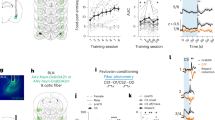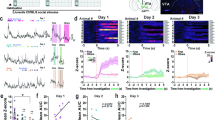Abstract
Nicotine exerts antinociceptive effects by interacting with one or more of the subtypes of nicotinic acetylcholine receptors (nAChRs) that are present throughout the neuronal pathways that respond to pain1,2,3,4,5. To identify the particular subunits involved in this process, we generated mice lacking the α4 subunit of the neuronal nAChR by homologous recombination techniques and studied these together with previously generated mutant mice lacking the β2 nAChR subunit6. Here we show that the homozygous α4−/− mice no longer express high-affinity [3H]nicotine and [3H]epibatidine binding sites throughout the brain. In addition, both types of mutant mice display a reduced antinociceptive effect of nicotine on the hot-plate test and diminished sensitivity to nicotine in the tail-flick test. Patch-clamp recordings further reveal that raphe magnus and thalamic neurons no longer respond to nicotine. The α4 nAChR subunit, possibly associated with the β2 nAChR subunit, is therefore crucial for nicotine-elicited antinociception.
This is a preview of subscription content, access via your institution
Access options
Subscribe to this journal
Receive 51 print issues and online access
$199.00 per year
only $3.90 per issue
Buy this article
- Purchase on Springer Link
- Instant access to full article PDF
Prices may be subject to local taxes which are calculated during checkout




Similar content being viewed by others
References
Iwamoto, E. T. Characterization of the antinociception induced by nicotine in the pedunculopontine tegmental nucleus and the nucleus raphe magnus. J. Pharmacol. Exp. Ther. 257, 120–133 (1991).
Bannon, A. W.et al. Broad-spectrum, non-opioid analgesic activity by selective modulation of neuronal nicotinic acetylcholine receptors. Science 279, 77–81 (1998).
Spande, T. F. et al. Epibatidine: a novel (chloropyridyl)azabicycloheptaine with potent analgesic activity from an Ecuadoran poison frog. J. Am. Chem. Soc. 114, 3475–3478 (1992).
Wada, E. et al. Distribution of α2, α3, α4, and β2 neuronal nicotinic receptor subunit mRNAs in the central nervous system: a hybridization histochemical study in the rat. J. Comp. Neurol. 284, 314–335 (1989).
Le Novère, N., Zoli, M. & Changeux, J. P. Neuronal nicotinic receptor α6 subunit mRNA is selectively concentrated in catecholaminergic nuclei of the rat brain. Eur. Neurosci. 8, 2428–2439 (1996).
Picciotto, M. et al. Abnormal avoidance learning in mice lacking functional high-affinity nicotine receptor in the brain. Nature 374, 65–67 (1995).
Zoli, M., Léna, C., Picciotto, M. R. & Changeux, J. P. Identification of four classes of brain nicotinic receptors using β-2 mutant mice. J. Neurosci. 18, 4461–4472 (1998).
Ramirez-Latorre, J. et al. Functional contributions of α5 subunit to neuronal acetylcholine receptor channels. Nature 380, 347–351 (1996).
Le Novère, N. & Changeux, J. P. Molecular evolution of the nicotinic acetylcholine receptor: an example of multigene family in excitable cells. J. Mol. Evol. 40, 155–172 (1995).
Clarke, P. B. S., Schwartz, R. D., Paul, S. M., Pert, C. B. & Pert, A. Nicotinic binding in rat brain: autoradiographic comparison of 3H-acetylcholine, 3H-nicotine, and 125I-α-bungarotoxin. J. Neurosci. 5, 1307–1315 (1985).
D'Amour, F. E. & Smith, D. L. Amethod for determining loss of pain sensation. J. Pharmacol. Exp. Ther. 72, 74–79 (1941).
Caggiula, A. R., Epstein, L. H., Perkins, K. A. & Saylor, S. Different methods of assessing nicotine-induced antinociception may engage different neural mechanisms. Physchopharmacology 122, 301–306 (1995).
Tripathi, H. L., Martin, B. R. & Aceto, M. D. Nicotine-induced antinociception in rats and mice: correlation with nicotine brain levels. J. Pharmacol. Exp. Ther. 221, 91–96 (1982).
Sahley, T. L. & Bernston, G. G. Antinociceptive effects of central and systemic administration of nicotine in the rat. Psychopharmacology 65, 279–283 (1979).
Jurna, I., Krauss, P. & Baldauf, J. Depression by nicotine of pain-related nociceptive activity in the rat thalamus and spinal cord. Clin. Pharmacol. 72, 65–73 (1993).
Bitner, R. S. et al. Role of the nucleus raphe magnus in antinociception produced by ABT-594: immediate early gene responses possibly linked to neuronal nicotinic acetylcholine receptors on serotonergic neurons. J. Neurosci. 18, 5426–5432 (1998).
Pan, Z. Z., Wessendorf, M. W. & Williams, J. T. Modulation by serotonin of the neurons in the rat nucleus raphe magnus in vitro. Neuroscience 54, 421–429 (1993).
Asghar, K. & Roth, L. J. Entry and distribution of hexamethonium in the central nervous system. Biochem. Pharmacol. 20, 2787–2795 (1971).
Rao, T. S., Correa, L. D., Reid, R. T. & Lloyd, G. K. Evaluation of anti-nociceptive effects of neuronal nicotinic acetylcholine receptor (NAChR) ligands in the rat tail-flick assay. Neuropharmacology 35, 393–405 (1996).
Flores, C. M., DeCamp, R. M., Kilo, S., Rogers, S. W. & Hargreaves, K. M. Neuronal nicotinic receptor expression in sensory neurons of the rat trigeminal ganglion: demonstration of α3β4, a novel subtype in the mammalian nervous system. J. Neurosci. 16, 7892–7901 (1996).
Damaj, M., Patrick, G., Creasy, K. & Martin, B. Pharmacology of lobeline, a nicotinic receptor ligand. J. Pharmacol. Toxicol. 282, 410–419 (1997). (AUTHOR: journal title OK?)
Picciotto, M. R. et al. Acetylcholine receptors containing the β2 subunit are involved in the reinforcing properties of nicotine. Nature 391, 173–177 (1998).
Tallarida, R. & Murray, R. Manual of Pharmacological Calculations with Computer Programs(Springer, New York, (1987).
Zimmerman, M. Ethical guidelines for investigations of experimental pain in conscious animals. Pain 16, 109 (1983).
Léna, C. & Changeux, J. P. Role of Ca2+ ions in nicotinic facilitation of GABA release in mouse thalamus. J. Neurosci. 17, 576–585 (1997).
Yagi, T. et al. Anovel negative selection for homologous recombinants using diphtheria toxin A fragment gene. Anal. Biochem. 214, 77–86 (1993).
Franklin, K. B. J. & Paxinos, G. The Mouse Brain in Stereotaxic Coordinates(Academic, San Diego, (1997).
Acknowledgements
The authors thank S. Brown and M. Picciotto for their contribution to this project; M.Zoli for scientific discussions; N. Bordes for help with experiments; and P. Parra, S. Edelstein and R.Klink for critical reading of the manuscript. This research was supported by grants from the Collège de France, the Association Francaise contre les Myopathies, Reynolds Pharm., EEC Biotech and Biomed Programs, the Council for Tobacco Research, the National Alliance for Research on Schizophrenia and Depression, and NIH (for M.I.D.).
Author information
Authors and Affiliations
Rights and permissions
About this article
Cite this article
Marubio, L., Arroyo-Jimenez, M., Cordero-Erausquin, M. et al. Reduced antinociception in mice lacking neuronal nicotinic receptor subunits. Nature 398, 805–810 (1999). https://doi.org/10.1038/19756
Received:
Accepted:
Issue Date:
DOI: https://doi.org/10.1038/19756
This article is cited by
-
NACHO and 14-3-3 promote expression of distinct subunit stoichiometries of the α4β2 acetylcholine receptor
Cellular and Molecular Life Sciences (2021)
-
Polyamine regulation of ion channel assembly and implications for nicotinic acetylcholine receptor pharmacology
Nature Communications (2020)
-
Potentiation of a neuronal nicotinic receptor via pseudo-agonist site
Cellular and Molecular Life Sciences (2019)
-
Antinociceptive effects of novel epibatidine analogs through activation of α4β2 nicotinic receptors
Science China Life Sciences (2018)
-
In vivo modulation of the behavioral effects of nicotine by the coumarins xanthotoxin, bergapten, and umbelliferone
Psychopharmacology (2016)
Comments
By submitting a comment you agree to abide by our Terms and Community Guidelines. If you find something abusive or that does not comply with our terms or guidelines please flag it as inappropriate.



